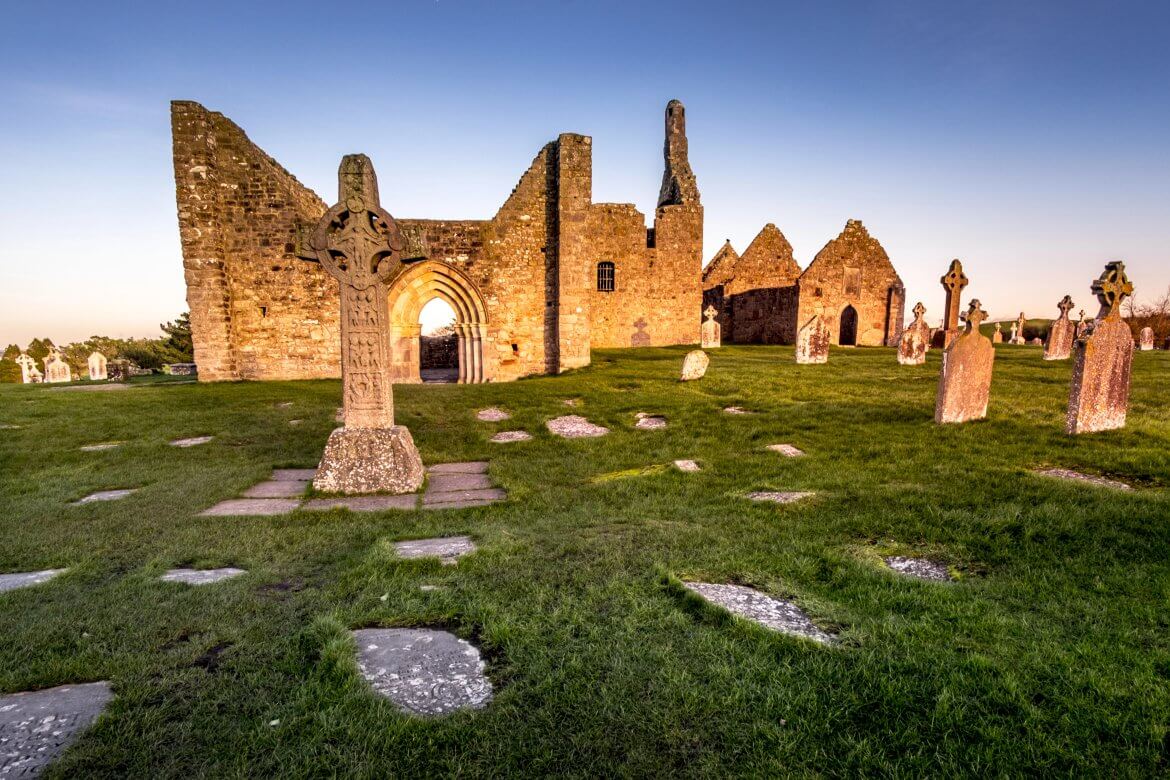In the emerald fields and windswept hills of Ireland stand the remnants of what was once one of the most powerful monastic networks in medieval Europe. The story of Irish monasteries is not just one of prayer and contemplation, but of power, learning, art, and ultimately, dramatic change.
The Dawn of Irish Monasticism
Christianity arrived in Ireland gradually, but it was St. Patrick’s mission in the 5th century that laid the groundwork for what would become a unique form of Celtic monasticism. Unlike the Roman model, which emphasized hierarchy and urban centers, Irish monasticism adapted to Ireland’s rural, clan-based society. The first monasteries were simple affairs – wooden buildings surrounded by earthen banks, often located on granted lands from local chiefs.
The Golden Age (6th-9th Centuries)
By the 6th century, Irish monasteries had evolved into something extraordinary. Centers like Clonmacnoise, Glendalough, and Bangor became not just religious houses but entire communities, often referred to as “monastic cities.” These settlements included churches, workshops, accommodation for monks and students, and facilities for caring for the sick and elderly.
What made Irish monasteries unique was their role as centers of learning during Europe’s Dark Ages. While much of continental Europe experienced a decline in literacy and learning following the fall of Rome, Irish monasteries became beacons of scholarship. Monks painstakingly copied and illuminated manuscripts, preserving classical texts alongside religious works. The Book of Kells, created around 800 AD, stands as perhaps the most famous example of this artistic and scholarly tradition.
Irish monasteries developed their distinctive architectural style, characterized by round towers, high crosses, and small churches. The round towers, reaching heights of up to 34 meters, served multiple purposes – bell towers, lookout posts, and refuges during Viking raids. The high crosses, elaborately carved with biblical scenes and Celtic patterns, served as teaching tools for an largely illiterate population.
Power and Influence
These monasteries wielded considerable power. Abbots often came from powerful families and could command resources comparable to regional kings. Monasteries controlled vast tracts of land, operated as centers of trade, and even minted their own coins. They also served as centers of innovation, developing new farming techniques and crafts.
The missionary zeal of Irish monks spread their influence far beyond Ireland’s shores. St. Columbanus, St. Aidan, and others established monasteries across Europe, from Iona in Scotland to Bobbio in Italy. These Irish monks played a crucial role in the spread of Christianity and learning throughout medieval Europe.
The Time of Troubles
The Viking raids of the 9th and 10th centuries marked the beginning of a long decline for Irish monasteries. Raiders targeted these wealthy centers, destroying buildings and stealing precious metalwork and manuscripts. While some monasteries rebuilt and fortified themselves – evidenced by the construction of many round towers during this period – the Viking age permanently altered the Irish monastic landscape.
The 12th century brought further changes with the arrival of continental religious orders – Cistercians, Augustinians, and others – who established new monasteries under stricter Roman rules. The traditional Celtic monastic system gradually gave way to these continental forms.
The final blow came with the Dissolution of the Monasteries under Henry VIII in the 16th century. Monasteries were closed, their lands seized, and their buildings left to decay. Some were converted to Protestant churches or secular uses, while others were simply abandoned to the elements.
Legacy and Modern Role
Today, Ireland’s monastic sites exist primarily as archaeological remains and tourist attractions. Places like Clonmacnoise, Glendalough, and the Skellig Islands draw visitors from around the world, offering glimpses into Ireland’s medieval religious life. The round towers and high crosses that dot the landscape serve as powerful reminders of this golden age.
However, monasticism in Ireland isn’t merely historical. New monasteries were established in Ireland during the 19th and 20th centuries, though following continental rather than Celtic models. Modern Irish monasteries like Glenstal Abbey continue traditions of scholarship and education, running schools and publishing works of academic and spiritual significance.
These contemporary monasteries play various roles in modern Ireland:
- Centers for spiritual retreat and contemplation
- Educational institutions
- Cultural preservation
- Agricultural innovation
- Community support
The archaeological remains of ancient monasteries also serve important functions in modern Ireland:
- Historical research and education
- Tourism and economic development
- Cultural identity and heritage
- Spiritual significance for both Christians and others
- Environmental conservation (many sites are now nature reserves)
The monastery ruins scattered across Ireland’s landscape tell a story of remarkable achievement and dramatic change. They remind us of a time when Ireland was known as the “Land of Saints and Scholars,” when its monasteries were centers of learning that helped preserve classical knowledge through Europe’s Dark Ages.
These sacred stones continue to inspire and intrigue, drawing people to contemplate both Ireland’s past and its ongoing spiritual traditions. While the great monastic cities of medieval Ireland may be gone, their influence endures in Ireland’s cultural memory and in the modern institutions that carry forward some of their traditional roles.
The story of Irish monasteries is, in many ways, the story of Ireland itself – one of cultural flowering, external pressures, dramatic changes, and ultimately, adaptation and survival. As Ireland continues to evolve, these ancient sites remain powerful symbols of the country’s rich cultural and spiritual heritage.


